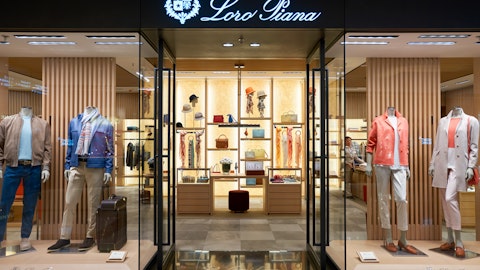Tapestry, Inc. (NYSE:TPR) Q2 2024 Earnings Call Transcript February 8, 2024
Tapestry, Inc. beats earnings expectations. Reported EPS is $1.63, expectations were $1.45. TPR isn’t one of the 30 most popular stocks among hedge funds at the end of the third quarter (see the details here).
Operator: Good day and welcome to this Tapestry Conference Call. Today’s call is being recorded. Later, you will have the opportunity to ask questions during the question-and-answer session. [Operator Instructions] At this time, for opening remarks and introductions, I would like to turn the call over to the Global Head of Investor Relations, Christina Colone.
Christina Colone: Good day. Thank you for joining us. With me today to discuss our second quarter results as well as our strategies and outlook are Joanne Crevoiserat, Tapestry’s Chief Executive Officer; and Scott Roe, Tapestry’s Chief Financial Officer and Chief Operating Officer. Before we begin, we must point out that this conference call will involve certain forward-looking statements within the meaning of the Private Securities Litigation Reform Act. This includes projections for our business in the current or future quarters or fiscal years. Forward-looking statements are not guarantees, and our actual results may differ materially from those expressed or implied in the forward-looking statements. Please refer to our annual report on Form 10-K, the press release we issued this morning and our other filings with the Securities and Exchange Commission for a complete list of risks and other important factors that could impact our future results and performance.
Non-GAAP financial measures are included in our comments today and in our presentation slides. For a full reconciliation to corresponding GAAP financial information, please visit our website www.tapestry.com/investors and then view the earnings release and the presentation posted today. Now let me outline the speakers and topics for this conference call. Joanne will begin with highlights for Tapestry in each of our brands. Scott will continue with our financial results, capital allocation priorities and our outlook going forward. Following that, we will hold a question-and-answer session where we will be joined by Todd Kahn, CEO and Brand President of Coach. After Q&A, Joanne will conclude with brief closing remarks. I’d now like to turn it over to Joanne Crevoiserat, Tapestry’s CEO.
Joanne Crevoiserat: Good morning. Thank you, Christina, and welcome, everyone. As noted in our press release, we delivered a strong holiday quarter, achieving record second quarter revenue and earnings per share with growth outpacing expectations. Importantly, we advanced our strategic agenda, driving consistent progress through the power of brand building, customer centricity and disciplined execution. I want to recognize our talented global teams whose creativity, passion and agility continue to fuel consumer engagement and our standout financial results. Touching on the highlights for the quarter. First, we powered global growth to achieve a 3% sales gain, demonstrating the benefits of our diversified business model. This increase was driven by 12% growth at constant currency internationally, which included 19% growth in Greater China, consistent with our expectations.
Further, sales to Chinese consumers globally grew at a mid-teens rate, which included continued growth with Chinese tourists. Looking ahead, we remain committed to investing in our brands, leveraging Tapestry’s established platform in the region to build our business not only in China, but with this important cohort worldwide. Turning to Japan. Revenue rose 6%. And in Other Asia and Europe, sales increased 9% and 11%, respectively with each delivering strong growth against last year’s double-digit gains. Finally, in North America, we delivered revenue in line with last year and better than our expectations. We are continuing to drive a healthy business, underscored by significant growth and operating margin expansion compared to last year and plan.
Second, we remain focused on building customer engagement across our brands. In the quarter, we acquired approximately 2.5 million new customers in North America alone, of which roughly half were Gen Z and Millennials, consistent with our strategy to recruit younger consumers to our brands. And we continue to see new customers transact at higher AUR than the balance of our customer base. At the same time, we improved lapsed customer reactivation in North America, demonstrating our ability to engage with our existing customer base while bringing new customers to our brands. Third, we delivered unique and seamless omni-channel experiences, reinforcing the benefits of our data-rich direct-to-consumer operating model. To this end, we drove mid-single-digit growth on a constant currency basis, both in stores and online as we continue to meet our customers where they choose to shop.
Our exceptional retail teams welcome more customers to our stores around the world, while we maintained our strong positioning in digital, which represented one-third of revenue. During the quarter, we were proud to open a new multi-brand fulfillment center in Las Vegas as we continue to invest in our omni-channel capabilities, supporting speed, sustainability and growth. Fourth, we fueled fashion innovation and product excellence by delivering compelling newness and value to consumers, which supported overall handbag AUR gains globally. At the same time, we drove growth in our small leather goods and lifestyle offerings, important for the holiday gifting season. Overall, we generated record second quarter EPS, which exceeded expectations and increased significantly compared to the prior year, highlighting the power of brand building and disciplined execution.
We achieved these strong results while making strategic investments in our brands to accelerate future growth. Now turning to the highlights across each of our brands, starting with Coach. We delivered another standout quarter as our team continues to fuel brand desire by bringing expressive luxury to life, a positioning that is relevant and unique to Coach. Our strategy supported by consistent execution are driving strong innovation, consumer connections and financial results, highlighted by revenue growth across geographies and significant margin expansion. Now touching on some details of the second quarter. We achieved growth in our leather goods offering fueled by our iconic platforms. Tabby again, outperformed expectations, nearly doubling versus last year and over-indexing with new and younger consumers at above-average AUR.
We’re continuing to bring newness to this iconic family across bags and small leather goods, including the recently launched Quilted Tabby with further runway ahead. At the same time, we drove growth across the balance of the assortment anchored by our Willow and Rogue families, which remain foundational volume drivers. We also drove momentum with the recently introduced Idle Family, expanding the offering with new sizes. Overall, our creative and innovative products supported a mid-single-digit gain in global handbag AUR including growth in North America. Looking forward, we see continued opportunity for pricing improvements given our innovation pipeline and brand heat. At the same time, we fueled gains in lifestyle as we focus on building the brand’s reach with consumers with the goal of powering customer recruitment, purchase frequency and ultimately, customer lifetime value.
In ready-to-wear, we advanced our strategy to build a core assortment of key styles that represent compelling value. Growth in the quarter was driven by outerwear. In footwear, the Leah Loafer continued to outperform. And in men’s leather goods, growth was driven by success in the key Gotham, Charter, Hitch and Relay families. Next, we created purpose-led storytelling, building meaningful emotional connections with the brand. We continue to lean into the strength of the Wear your Shine campaign, which inspires consumers to use fashion as a means for personal expression and empowerment. The Shine collection included a range of gold and metallic bags, ready-to-wear and accessories, allowing customers to own their shine with confidence. We also delivered emotional content through our More than a Gift campaign, which celebrates the gifts that give us the confidence to be ourselves.
Overall, the success of these campaigns helped to support the acquisition of approximately 1.5 million new customers in North America, including a growing number of Gen Z and Millennials. And according to US brand tracking work fielded during the quarter, Coach saw a lift in unaided awareness versus prior year led by gains with Gen Z consumers, underscoring that our investments in brand building are working. And finally, we continue to build momentum in our sub-brand Coachtopia, a re-imagination of the product creation process to evolve our vision of circularity. During the quarter, Coachtopia’s Ergo shoulder bag made with either repurposed leather or leather scraps was the top-selling style. While Coachtopia remains a small portion of the assortment, we are excited by the significant consumer attention it’s receiving specifically with younger audiences.
In closing, Coach continues to build strength on strength, with a clear strategy, unique purpose and commitment to investing behind sustainable growth. The power of expressive luxury rooted in deep consumer insights and consistent execution is bringing new innovation, new customers and new potential to this iconic brand, and we’re confident in the tremendous runway ahead. Now moving to Kate Spade. During the quarter, we continued to advance our long-term priorities, reinforcing our strategic direction. Profits were ahead of both expectations and the prior year, led by gross margin expansion, demonstrating our agility and discipline. Having said that, top line trends remain challenged. In order to realize the ambition we have for the brand, we need to accelerate our progress through improved execution.
To this end, we see an opportunity in three key areas. First, strengthening Kate Spade’s core bag offering. Second, powering the omni-channel experience and third, driving more emotional marketing that fuels brand relevance and heat. Now I’ll touch on our quarterly results in each of these focus areas in more detail. First, we are reimagining and broadening the brand’s core handbag assortment across channels, creating the foundation to be a larger and more profitable brand consistent with our strategic intent. And where we’ve provided more newness, innovation and emotion, our customers have responded. However, the traction we’ve seen with new products was offset by declines in carryover families, which underperformed our expectation. This reinforces the need to move faster to build a more innovative core assortment that’s required to win in today’s dynamic consumer backdrop.
Moving forward, we are laser-focused on improving the execution of our handbag offering, bringing more relevancy to the assortment. The pipeline for the back half of the year and into fiscal year ’25 will increase the penetration of newness across channels with the launch of bags featuring new materials, silhouettes and distinctive branding elements. This innovation builds on the green shoots we’re seeing today, while incorporating consumer feedback and insights, which help to inform our product strategies and investments. At the same time, we’ll maintain the strength of our novelty and lifestyle offerings, differentiators for the Kate Spade brand. To this point, footwear rose double-digits in the quarter, while jewelry remains an important acquisition vehicle consistent with our strategy and focus on enhancing customer lifetime value.
Second, the execution of a cohesive omni-channel strategy is a key opportunity to drive stronger customer engagement. During the quarter, we launched a dedicated katespadeoutlet.com site, replacing the brand’ surprise site and providing a more seamless way for outlet consumers to discover and shop the brand online. Overall, by bringing a more focused and unified experience to consumers across all brand touch points, we can more efficiently scale our marketing and merchandising efforts, supporting our goal of driving sustainable direct-to-consumer growth. Third, we are focused on creating emotional marketing that fuels brand relevance and heat on a global scale. During the quarter, our marketing investments supported the acquisition of approximately 950,000 new customers to the brand in North America.
In keeping with our strategy to become a more global brand, we launched a series of physical activations from London to Shanghai that brought the brand’s codes to life and helped to grow brand awareness internationally Moving forward, we recognize the need to distort our marketing efforts to brand building to enhance our impact. Unique storytelling has been a strength of the brand over time. And as we move into spring, we will focus on creating marketing to drive fashion credibility and customer engagement by shifting our investment to top-of-funnel marketing through the launch of our campaign anchored in the brand codes of joy, color and New York City. Finally, as we fuel enhanced innovation, we will maintain a commitment to operational excellence, positioning the brand for long-term success.
This focus has supported the brand’s meaningful gross margin and profit expansion thus far this year and is embedded in our strategies and ways of working for the future. Overall, while we’re continuing to advance our long-term strategies at Kate Spade, we’re leaning in with intention to accelerate our progress. Our path forward is clear and our vision for the brand and its potential is unchanged. Turning to Stuart Weitzman. Top line results in the quarter were pressured, reflecting in part the on-going strategic reduction and off-price wholesale shipments. These headwinds were partially offset by growth in China against last year’s COVID-impacted compare and continued positive wholesale POS trends. Further, we grew AUR, expanded gross margin and improved profitability versus prior year.
That said, we remain unsatisfied with the brand’s pace of recovery, and we continue to focus on prioritizing brand health and delivering innovation for consumers. Touching on key elements of the brand’s strategic growth pillars from the quarter. First, we curated a relevant offering of emotional product. We delivered growth in our core boot classification, fueled by gains in the SoHo and 5050 families. Further, we continued to build out our assortment with more seasonless casual styles, including loafers and belle flats. During the quarter, we also launched a new sneaker assortment featuring a range of innovative designs, engineered to combine fashion and function. At the same time, our handbag collection, while still a small portion of the assortment, drove growth at high AUR.

As we move forward, we will deliver more newness into the core assortment in keeping with rapidly evolving consumer trends. Next, we created engaging marketing to fuel brand heat and consideration. In celebration of the brand’s 30th anniversary, we employed a multipronged approach to our marketing, including utilizing an array of influencers to organically engage with consumers from He Kong to Kim Kardashian to Sofia Richie Grainge. As a result, we saw brand awareness improve in the US per YouGov and drove increased customer engagement across our social channels. Similarly, in China, brand exposure rose significantly following the launch of this campaign. Overall, the Stuart Weitzman team is focused on executing against its strategic priorities, fueling brand heat and deepening customer engagement through a stronger, more diversified foundation of differentiated product and emotional purpose-led storytelling to drive enhanced growth and profitability long term.
In closing, Tapestry delivered a strong second quarter, positioning us to raise our earnings per share outlook for the fiscal year. Importantly, this reflects the progress we’re making to advance our strategic agenda and power our iconic brands to move at the speed of the consumer in an ever-changing environment while investing in our future. We remain confident in our vision and in our ability to bring that vision to life, putting the customer at the center of everything we do to drive sustainable organic top and bottom line gains. Further, through the planned acquisition of Capri, we see a significant opportunity to accelerate our strategies while driving accretion to our strong stand-alone financial plan. Overall, we remain excited by the opportunity to expand our house of powerful brands, positioning Tapestry as a leader in innovation, talent development and shareholder returns for years to come.
We continue to make progress towards closing the transaction and look forward to sharing more detailed growth strategies for the future at an appropriate time. With that, I’ll turn it over to Scott, who will discuss financial results, capital priorities and fiscal ’24 outlook. Scott?
Scott Roe: Thanks, Joanne, and good morning, everyone. As Joanne mentioned, our fiscal Q2 results exceeded expectations. We delivered top line growth, significantly expanded gross margin and drove record revenue and EPS for the key holiday quarter while generating over $800 million in free cash flow. Our strong and consistent performance demonstrates the benefit of our globally diversified direct-to-consumer business model as well as our financial discipline and agility. It’s this discipline that allows us to continue to invest in long-term brand growth while delivering record earnings. Now moving to the details of the quarter, beginning with revenue trends on a constant currency basis. Sales increased 3% compared to the prior year, fueled by strong international growth of 12%.
In Greater China, revenue rose 19% as we anniversaried last year’s COVID impacted results. At the same time, we’ve continued to see an uptick in travel spend from Mainland China tourist with increases across Asia and Europe. While these trends have been encouraging, sales to Chinese tourists globally remain well below pre-pandemic levels, representing further opportunity ahead. Outside of China, we drove growth in our key international regions, anniversarying strong gains in the prior year. In Japan, sales grew 6% due to increased tourist demand, and in Other Asia, revenue grew 9%, including strength in Korea, Singapore, Australia and New Zealand. In Europe, momentum continued with revenue 11% above last year. And in North America, sales were in line with the prior year and above expectations on stronger margins, supporting brand health and not chasing sales.
Now touching on revenue by channel for the quarter. Our direct-to-consumer business grew 4%, fueled by mid-single-digit growth in both stores and digital. And in wholesale, which represents about 10% of sales globally, revenue declined 4%, reflecting wholesale market pressure in North America, partially offset by growth in international accounts. Moving down to P&L. We delivered our strongest second quarter gross margin in over a decade, which was ahead of our expectations and 300 basis points above last year. This year-over-year expansion was driven by a benefit of 170 basis points due to lower freight expense as well as operational outperformance, fueled by geographic mix tailwinds and net pricing improvements. SG&A rose 5%, which was favorable to our forecast on both a dollar and a rate basis, reflecting operational savings compared to plan.
Importantly, we’re continuing to tightly control costs while making ongoing strategic investments in our brands, people and business platforms. So taken together, operating margin expanded 220 basis points and operating income rose 14% compared to the prior year, both ahead of our expectations. And our record second quarter EPS of $1.63 was ahead of guidance and represented growth of 20%. Now turning to our balance sheet and cash flows. We ended the quarter with $7.5 billion in cash and investments and total borrowings of $7.7 billion, which reflects the bond financing related to the planned acquisition of Capri, which I’ll touch on momentarily. Free cash flow for the quarter was an inflow of $804 million. CapEx and implementation costs related to cloud computing were $30 million.
And inventory levels at quarter end were 15% below prior year, reflecting our focus on disciplined inventory management and driving inventory turn. Before moving on, I did want to touch on the disruption related to the Red Sea conflict. We’re closely monitoring this situation and currently estimate a modest increase in lead times and freight costs in the back half of the fiscal year, which has been incorporated in the outlook provided today. Importantly, we currently anticipate minimal impact to our operating results and customer experience given our well-positioned inventory. Turning to our dividend program. Our Board of Directors declared a quarterly cash dividend of $0.35 per common share, representing $81 million in dividend payments for the quarter.
For the fiscal year, we continue to expect to return approximately $325 million to shareholders through the dividend at an annual rate of $1.40 per share, a 17% increase compared to last year. Now moving to our guidance for fiscal ’24, which is provided on non-GAAP basis and does not include any potential impact from the planned acquisition of Capri. Our strong second quarter results position us to raise our EPS outlook for the fiscal year, while taking a prudent approach to our second half planning. On revenue, we’re maintaining our outlook on a reported basis as we reflect Coach’s outperformance in the second quarter as well as moderating headwinds from FX, offset by lower expectations at Kate Spade and Stuart Weitzman. At the same time, we’re raising our EPS estimate for the year, given our stronger margin results and commitment to being disciplined stewards of our brands.
Our guidance also reflects the strategic decision to invest a portion of our Q2 profit be back into our brands and business to support our long-term strategies. Moving to the fiscal year in further detail. We expect revenue of approximately $6.7 billion, representing an increase in the area of 1% versus prior year on a reported basis. Excluding an FX headwind of roughly 100 basis points, we anticipate constant currency sales growth of 2%. Turning to sales details by region at constant currency, which are unchanged from the ranges previously provided. In North America, we expect revenue to be in line with to slightly above prior year. This forecast contemplates our commitment to maintaining higher margins as we manage our brands and business for the long term.
In Greater China, we expect mid-single-digit sales growth. In Japan, revenue is forecasted to grow mid-single digits, while Other Asia is expected to increase at a low double-digit rate. And in Europe, we anticipate high single-digit growth. In addition, our outlook assumes operating margin expansion of approximately 100 basis points. We anticipate gross margin gains in the area of 200 basis points, which includes a benefit from moderating freight costs of roughly 120 basis points. On SG&A expenses, we expect deleverage of roughly 100 basis points, reflecting reinvestments in our brands, people and business in supportive growth initiatives. Moving to the below-the-line expectations for the year. Net interest expense is anticipated to be approximately $20 million.
The tax rate is expected to be approximately 20%, and our weighted average diluted share count is forecasted to be in the area of 233 million shares. So taken together, we’re now projecting EPS of $4.20 to $4.25, representing 8% to 9% growth versus last year. Finally, before contemplating any deal-related costs, we still anticipate free cash flow of approximately $1.1 billion, and we expect CapEx and cloud computing costs to be in the area of $190 million. This forecast includes roughly half of the spend to be related to store openings, renovations and relocations mostly in Asia, with the balance primarily related to our ongoing digital and IT investments. Now let me take you through the shaping of the year. We continue to expect relatively consistent constant currency top line growth between the first half and second half at around 2%.
This includes the expectation for stronger growth in the fourth quarter relative to the third quarter, helped by the anniversary of easier comparisons in North America. On operating income, as noted, we’re utilizing a portion of our outperformance in the second quarter to reinvest in our people, brands and business. Therefore, our outlook now contemplates second half operating income to be roughly in line with the prior year. By quarter, we expect gross margin expansion in both the third and fourth quarters, with modestly higher SG&A dollar growth in Q3 versus Q4 based on the pace of our investments versus the prior year. For the third quarter specifically, we anticipate revenue to be in line with to slightly above prior year in constant currency and down slightly on a reported basis, including roughly 120 basis points of FX pressure.
In aggregate, we expect EPS for the third quarter to be in the area of $0.65, with growth anticipated for Q4. Now to outline our capital allocation priorities looking forward, which are unchanged. First, we will invest in our brands and businesses to support sustainable growth. Second, we will utilize our strong free cash flow for rapid debt repayment. We are committed to maintaining a solid investment-grade rating. To this end, we initiated a long-term leverage target of less than 2.5 times on a gross debt to adjusted EBITDA basis and expect to achieve that within with years of the Capri transaction close. Finally, we will return capital to shareholders through our dividend. Importantly, we believe our strong cash flow profile provides us with further opportunity for investment and capital return.
Following the achievement of our leverage target, over time, we expect to increase our dividend with the goal of achieving our stated target payout ratio of 35% to 40% and see the opportunity to resume share repurchases in the future. Before closing, I want to touch more holistically on the planned acquisition of Capri. We believe the acquisition will drive significant value creation with immediate accretion to adjusted earnings, enhanced cash flow and strong financial returns, underpinned by a compelling industrial logic that is consistent with our commitment to being disciplined financial operators. To this end, it’s important to highlight that we continue to expect Capri to generate double-digit EPS accretion on an adjusted basis and compelling ROIC.
Embedded in these expectations is the assumption that the stand-alone Capri business will generate free cash flow in the area of $500 million on a non-GAAP unsynergized basis. And as noted, we’ve made further progress towards transaction close. In November, we issued $6.1 billion in USD and euro bonds, achieving an all-in debt interest rate of 6.5%, inclusive of Tapestry’s existing debt and consistent with our expectations. Our financing strategy supports rapid debt pay-down in order to achieve our stated leverage target within 24 months post close, given the combined company’s strong free cash flow generation. We’re moving forward with integration planning efforts and continue to gain confidence in our ability to achieve run rate cost synergies of over $200 million within three years of closing.
And finally, we’re continuing to work towards receiving all required regulatory approvals, and as publicly announced by the Chinese Regulatory Authority, the transaction received clearance in China. In terms of timing, we remain confident in our ability to complete the transaction with a close expected in calendar 2024, consistent with our original expectations. In closing, for the quarter, we drove strong results, highlighted by revenue gains, significant margin expansion, earnings growth and cash flow generation while continuing to invest in the long-term growth of our business. This outperformance demonstrates the power of our strategies, operating model and talented global teams. Looking forward, we will remain disciplined stewards of our brands and business with an unwavering commitment to drive sustainable, profitable growth and shareholder returns for years to come.
With that, I’ll turn it back to the operator and take your questions.
Operator: [Operator Instructions] Our first question comes from Bob Drbul of Guggenheim.
See also 20 Highest Quality Beers in the US and 12 Best American Bank Stocks To Buy According to Analysts.
Q&A Session
Follow Tapestry Inc. (NYSE:TPR)
Follow Tapestry Inc. (NYSE:TPR)
Robert Drbul: Hi. Good morning. Congratulations on a great quarter. Can you talk about the strength you’re seeing at Coach at the Coach brand and your confidence in maintaining the momentum? And separately, I just have a question on the deal. Since you announced the transaction, we’ve seen a softening of trends at Capri. Can you just give us an update on if and how this has changed any of your thinking? Thanks.
Joanne Crevoiserat: Good morning, Bob. We delivered a solid holiday quarter, which is a testament to the strong and passionate teams we have around the world. And first, I want to recognize that we are executing consistently. We delivered growth across revenue, operating income and earnings per share. In fact, we delivered record second quarter earnings per share. And at the same time, we’re delivering gross margin and operating margin expansion, really showing that we’re maintaining brand health while delivering against our earnings commitments, which is protecting the bright future we see for our brand. These results speak to the operational excellence and the discipline that we’ve shown now for over three years, and we’re driving strong and consistent free cash flow.
And to your point, importantly, we are gaining momentum at Coach. And instead of stealing all of Todd’s thunder, maybe I’ll pass it to him to let him comment on that momentum, the sustainability of that momentum and then I’ll come back at the end and pick up your question on the acquisition. Todd?
Todd Kahn: Thank you, Joanne, and good morning, Bob. I’m feeling very confident about our future because of our brand positioning of expressive luxury, which we launched in September of ’23. What it did, it provided us with a clarity and focus on the target market, the timeless Gen Z consumer. With that consumer in mind this fall and into holiday, we launched our Wear your Shine campaign. The traction that we’ve seen with this campaign building on momentum of previous purpose campaign confirms the opportunity to talk to our clients in an authentic, unique and meaningful way. Turning to product. Our innovation is working as demonstrated by our Tabby family, which I can’t talk enough about. So when you take our storytelling and compelling product together, we are driving meaningful growth with new and younger consumers and generating brand heat.
This leads me to talk about what we refer to as coachgenomic. We grow our gross margin by reducing COGS, increasing initial pricing and reducing promotions, coupled with efficient non-marketing SG&A, allows us to invest in full funnel marketing, which drives productive sales. This creates a virtuous flywheel. Growing sales enhances the lifetime value of our new and younger clients. Our coachgenomic model bodes well for our future growth in the quarters and years ahead.
Joanne Crevoiserat: Well, thanks, Todd. And let me pick up on your question on the acquisition. I’ll start by saying these are great brands, and we remain excited about the runway ahead. We recognize the opportunity to unlock value by improving execution, leveraging the Tapestry platform, and we have continued confidence evidenced by the coach results that Todd just referenced, that our strategies and our execution deliver. And in terms of the deal, the economics remain strong. We’re making progress as we expected towards the close in this calendar year that’s unchanged from our prior outlook. And in the meantime, integration planning efforts continue. I’ve been impressed with how the teams are working together. And we continue to gain confidence in the opportunities where we can add value. Importantly, though, we remain laser-focused on driving our organic business, which is reflected in the strong second quarter beat and raise we reported today.
Robert Drbul: Thank you.
Operator: We’ll take our next question from Ike Boruchow of Wells Fargo.
Ike Boruchow: Hey, good morning. I’ll add my congrats. So I guess maybe this is for Scott or Joanne. But I think, Scott, back in August, I’m trying to think about the business organically, so excluding the pre any deals. In August, you gave us some updated thoughts on the fiscal ’25 organic goals you guys have set for yourself, which included the 19% margins and you took the $5 down to $465 because of the lack of repo. Curious if you could give us some updated thoughts on how those targets are evolving internally? And really, Scott, I’m specifically asking because your brand performance looks very different versus your initial goals with the Coach margins looking to come in at least this year, probably a few hundred basis points above the 30% goal you set for fiscal ’25 and kind of the opposite several hundred basis points below the mid-teens goals.
So any just thoughts on how that’s all evolving would help us when we kind of think about the business organically into next year.
Scott Roe: Yes, sure. I’m happy to take it. So just to reiterate, first of all, the $465, which is really the — as you said, the $5was the curtailment of the share repos, we still have confidence. And yes, has it evolved a little differently? It has. But I think not only is this a testament to the momentum that you see in Coach, but also, I think it speaks to our model, right? And the discipline being capital allocators. We’re feeding those opportunities where we see growth. You’re seeing the discipline across the P&L, as Joanne mentioned, in terms of gross margin expansion. We’re getting leverage across most cost areas and reinvesting back where we see points of difference in the ability to drive the brand. So while it’s evolved a little bit differently, yes, we still have the confidence, and I think that just speaks to the diversity of the model and I think the discipline in this organization.





